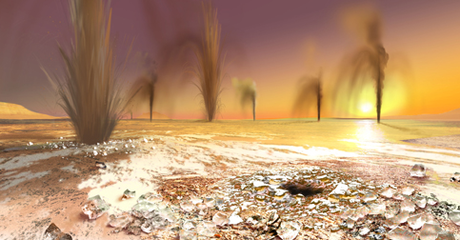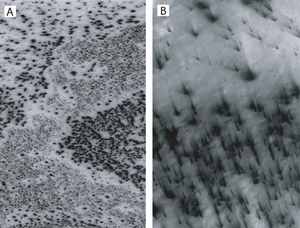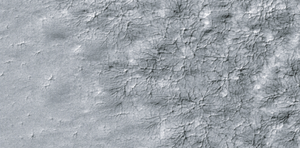2. Gas jets spawn dark 'spiders' and spots on Mars icecap

SAND-LADEN JETS
Sand-laden jets shoot into the polar sky in this view by noted space artist Ron Miller. It shows the Martian south polar icecap as southern spring begins. Click on the image to download a 5.6MB version.
(Image Credit: Arizona State University/Ron Miller)
Scientists use THEMIS data to discover that sand-spewing gas jets are the cause of mysterious dark markings that appear every spring on the Martian south polar cap.
Every spring it happens. As the Sun peeks above the horizon at the Martian south polar icecap, powerful jets of carbon-dioxide (CO2) gas erupt through the icecap's topmost layer. The jets climb high into the thin, cold air, carrying fine, dark sand and spraying it for hundreds of feet around each jet.
This dramatic scene emerges from new research by a team of Mars scientists that includes Arizona State University's Phil Christensen. The research report, co-authored with Hugh Kieffer (U.S. Geological Survey, retired) and Timothy Titus (USGS), appears in the August 17, 2006 issue of Nature. The new work solves a longstanding Martian polar riddle.
"If you were there," says Christensen, "you'd be standing on a slab of carbon-dioxide ice." Looking down, you would see dark ground below the 3-foot-thick ice layer. "All around you, roaring jets of CO2 gas are throwing sand and dust a couple hundred feet into the air."
You'd also feel vibration through your spacesuit boots, he says. "The ice slab you're standing on is levitated above the ground by the pressure of gas at the base of the ice."
Mystery Markings
The team began its research in an attempt to explain what caused mysterious dark spots, fan-like markings, and spider-shaped features on the icecap at the Martian south pole. The dark spots, typically 50 to 150 feet wide and spaced several hundred feet apart, appear every southern spring as the Sun rises over the icecap. They last for three or four months and then vanish - only to reappear the next year, after winter's cold has deposited a fresh layer of ice on the cap. Most spots even seem to recur at the same locations.
"Originally, scientists thought the spots were patches of warm, bare ground exposed as the ice disappeared," notes Christensen. "But observations made with THEMIS on NASA's Mars Odyssey orbiter told us the spots were nearly as cold as the CO2 ice, which is at -198° Fahrenheit." That finding suggested the spots were just a thin layer of dark material lying on top of the ice and kept chilled by it.
THEMIS is the Thermal Emission Imaging System, a multi-wavelength camera. Christensen designed THEMIS and is the instrument's principal investigator.
Using more than 200 THEMIS visible and infrared images, the team studied one area on the icecap, at 99° east longitude and 86.3° south latitude, from the end of southern winter through mid-summer. The spots began to appear when the Sun was only half a degree high, then quickly became more numerous over several days.
"A few places remained spot-free for more than 100 days," notes Christensen. "Then they developed a large number in a week."
The scientists saw that fan-shaped dark markings didn't form until days or weeks after the spots first appeared, yet some fans grew to half a mile in length. Even more puzzling was the origin of the "spiders," grooves eroded into the surface under the ice. The grooves converge at points directly beneath a spot.
Icy Greenhouse
"The key to figuring out the spiders and the spots," says Christensen, "was thinking through a physical model for what was happening." The whole process, he explains, begins during Mars' frigid Antarctic winter, when temperatures drop to -200° F. That's so cold that the Martian air - 95 percent carbon dioxide - freezes out directly onto the surface of the permanent polar cap, which is made of water ice covered with layers of dust and sand.
This seasonal deposit begins as a layer of dusty CO2 frost. Over the winter, the frost recrystalizes and becomes denser, a process called annealing. The dust and sand particles caught in the frost slowly sink. By spring, with the Sun about to rise, the frost layer has become a slab of semi-transparent ice about 3 feet thick, lying on a substrate of dark sand and dust.
Sunlight passing through the slab reaches the dark material and warms it enough that the ice touching the ground sublimates - it turns directly into gas. As days pass and the Sun rises higher, sublimation continues. Before long, the warmed substrate generates a reservoir of pressurized gas under the slab, lifting it off the ground.
Big Blowout
Soon after, weak spots in the slab break through, forming narrow vents, and high-pressure gas roars out at speeds of 100 miles per hour or more. Under the slab, the gas erodes the ground as it rushes toward the vents, snatching up loose particles of sand and carving networks of grooves that converge on the vents.
"Once a spider becomes established," says Christensen, "it affects the surface so that a vent will form in the same place the following year."
As they erupt, the jets carry loose sand and particles high in the air. The largest and heaviest particles fall closest to the vent, piling up around it to make the spots. As lighter sand grains tossed out by the jet blow downwind, they create the fans, which can extend tens to hundreds of yards. The lightest particles, meanwhile, drift away on the wind to form a thin layer of dust.
"It's like separating wheat and chaff," explains Christensen. "The finest-grained materials are carried off by the wind, while coarser grains are sifted again and again, year after year."
The vents and jets continue to erupt until the ice slab completely sublimates and vanishes.
This mechanism, says Christensen, "is unlike anything that occurs on Earth."
Other News & Discoveries

DARK SPOTS
Dark Spots (left) and fans scribble dusty hieroglyphics on top of the Martian south polar cap in two high-resolution MOC images taken in southern spring. Each image is about 2 miles wide. Click on the image to download a 976KB version.
(Image Credit: NASA/JPL/MSSS)
Download Original
SPIDERS TRACE
Spiders trace a delicate pattern on top of the residual polar cap, after the seasonal carbon-dioxide ice slab has disappeared. Next spring, these will likely mark the sites of vents when the CO2 icecap returns. This MOC image is about 2 miles wide. Click on the image to download an 824KB version
(Image Credit: NASA/JPL/MSSS)
Download Original